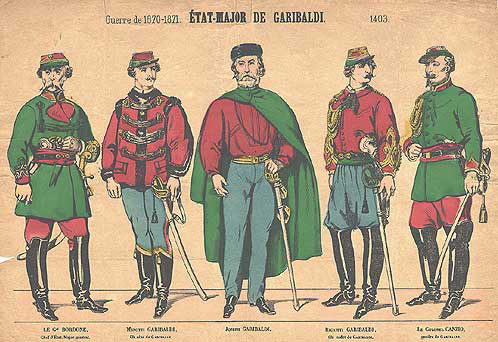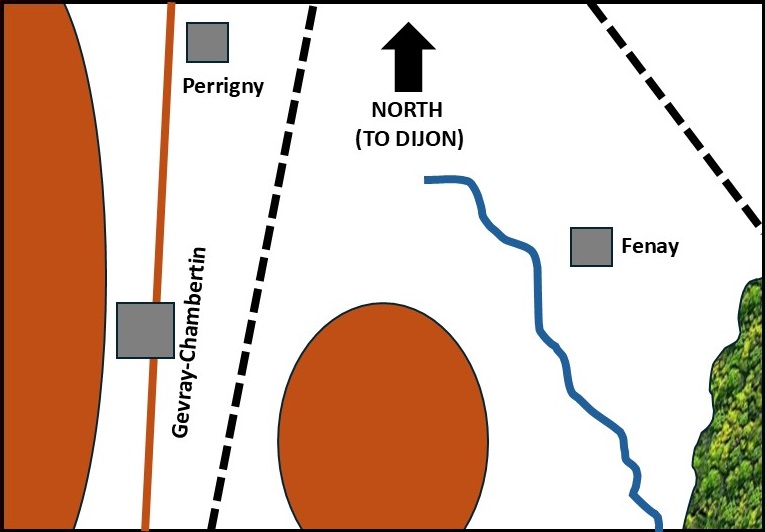Dijon, December 1870
A Scenario for La Guerre á Outrance


This scenario is loosely based on the 2nd Battle of Dijon in December of 1870, in which the French under Garibaldi attempt to stop the Prussians from moving south out of Dijon towards Nuits.
In late October, the Prussians had taken Dijon after figfhting against the forces of Colonel Fauconnet, who fell back on Beaune. Subsequently, Garibaldi, who commanded a force made up of his own foreign volunteers, Gardes Mobiles, and troops from Africa had established a base in Autun, and was attacking the supply lines from Strasbourg to Paris with some success. In December, the XIV Corps made up of troops from Baden marched south from Dijon and encountered Garibaldi's forces. After a fierce fight in which Von Werder used his superior numbers to work around the right flank of his opponents, the French fell back. They had inflicted several hundred casualties on the Prussians, however, even wounding Prince Wilhelm of Baden. While not a major axis of operations for the Prussians, such actions did serve to tie up significant numbers of Prussian troops.
Bourbaki's arrival in the area forced the Prussians to withdraw from Dijon, which was subsequently occupied by Garibaldi's men.
This scenario has been adjusted to use 25/28mm miniatures: all distances are doubled.
The map below is a 5' x 4' table depicting the plain between Dijon and Nuit. The dashed lines are railroad tracks, which will proivide soft cover to units directly behind them. The stream is fordable but rough, and provides the equivalent of soft cover to units being assaulted when defending the far bank. The hills and woods are rough and provide soft cover. The Towns all provide hard cover. Up to 2 units may deploy in Gevray-Chambertin, but only one unit in each of the other two (they are smaller villages).

The French will set up first, on or to the south of a line drawn east-west going across the north edge of Fenay. The 1st Prussian Division will march onto the table from the north edge, entering at the road. The second Prussian Division will enter on the north or eastern boatrd edges to the north and east of the rail line in that corner of the table. For this force to enter, you must roll a 6-sided die and score less than the turn number. Corps assets may enter at any time, anywhere on the northern board edge.
General Giuseppe Garibaldi's Command:
Corps General (Garibaldi)
Volunteer Division
Divisional General
2 Brigades Foreign Volunteers (French Mobilisé Infantry) (each 4 bases)
1 Brigades French Garde Mobilisé Infantry (4 bases)
Divisional Artillery (1 base)
African Division
Divisional General
2 Brigades Zouaves/Turcos (French Guard Infantry) (each 4 bases)
1 Brigade Chassuers d'Afrique (French Line Cavalry) (4 bases)
Divisional Artillery (1 base)
General August von Werder's Command:
XIV Corps General (Von Werder)
1st Division
Divisional General
2 Brigades Regular Infantry (each 4 bases)
1 Cavalry Regiment (2 bases)
Divisional Artillery (2 bases)
2nd Division
Divisional General
3 Brigades Regular Infantry (each 4 bases)
1 Cavalry Regiment (2 bases)
Divisional Artillery (2 bases)
Cavalry Brigade (4 bases)
Corps Artillery (1 base)
This game will play for 12 turns. If either army loses more than half of its component units (5+ for the French, 6+ for the Prussians), that army is broken and has lost the game. Otherwise, the Prussians must have exited at least 3 units off the southern board edge by the end of the game to win, at least one of which must be an infantry brigade. If the French are unbroken at the game's end and the Prussians have not met this condition, it is a French victory.